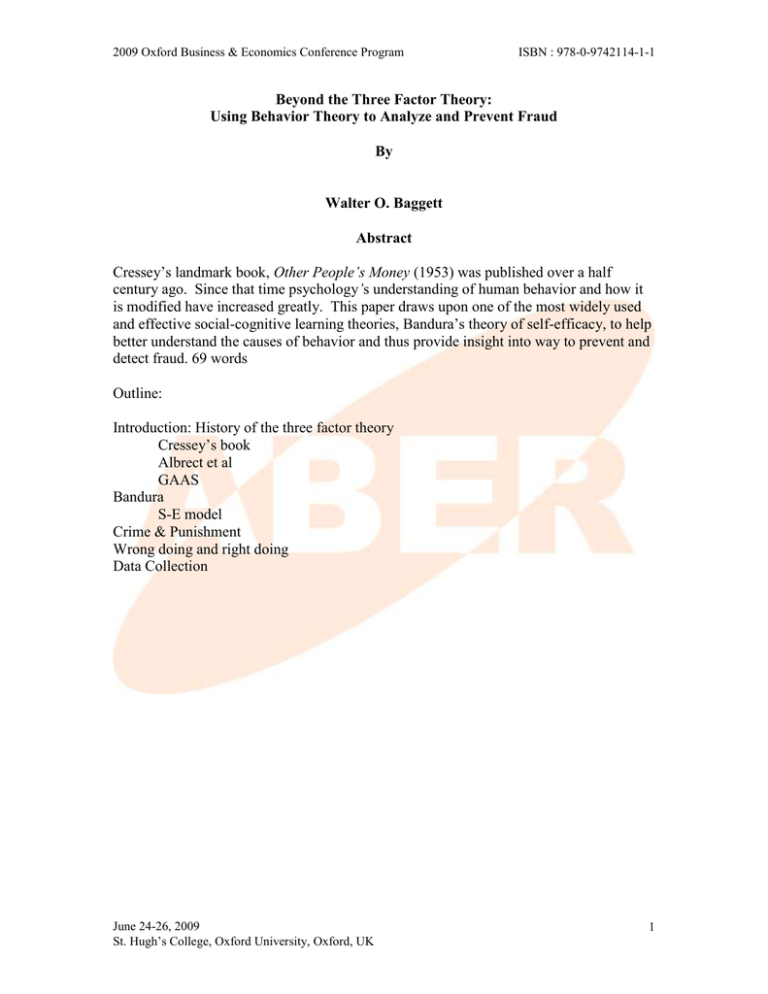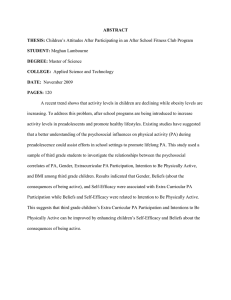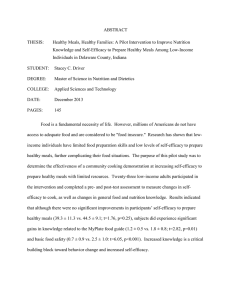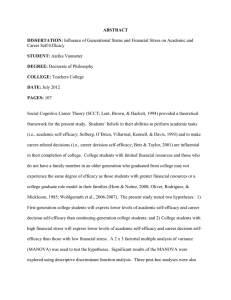Beyond The Three Factor Theory: Using Behavior Theory To Analyze And Prevent Fraud
advertisement

2009 Oxford Business & Economics Conference Program ISBN : 978-0-9742114-1-1 Beyond the Three Factor Theory: Using Behavior Theory to Analyze and Prevent Fraud By Walter O. Baggett Abstract Cressey’s landmark book, Other People’s Money (1953) was published over a half century ago. Since that time psychology’s understanding of human behavior and how it is modified have increased greatly. This paper draws upon one of the most widely used and effective social-cognitive learning theories, Bandura’s theory of self-efficacy, to help better understand the causes of behavior and thus provide insight into way to prevent and detect fraud. 69 words Outline: Introduction: History of the three factor theory Cressey’s book Albrect et al GAAS Bandura S-E model Crime & Punishment Wrong doing and right doing Data Collection June 24-26, 2009 St. Hugh’s College, Oxford University, Oxford, UK 1 2009 Oxford Business & Economics Conference Program ISBN : 978-0-9742114-1-1 Beyond the Three Factor Theory: Using Behavior Theory to Analyze and Prevent Fraud Cressey’s landmark book, Other People’s Money (1953) was published over a half century ago. In that book he lays out the three factor theory where “…three events make up the conditions under which trust violation occurs, and the term “cause” may be applied at that juncture” (p. 139). The three factors are an unmet, usually secret, need, opportunity and a lack of moral will, often described as a rationalization, that lets the behavior occur. In the book Cressey address the problem of fraud as one of violating a trust. At one point he refers to Kurt Lewin’s systematic causation whereby a person’s combination of experience and training interact with elements of situation to create behavior (p. 13). In effect, he appears to consider the traits of an individual to be shaped by some sort of learning process that is based upon experience. Actual trait research is extensive and has been reviewed in detail by Albrecht et al. (1982). While their review covers most of this research, it still appears to conclude that the three factor theory is the best, or at least the most succinct, approach to understanding fraud. The less simple approach is their red flag list which is comprised of literally dozens of items in some XX categories. The influence of the three factor theory on the auditing profession is further reinforced by the fact that SAS 99 had added it to the formal auditing literature. Right at the beginning of the standard in ¶§? 7, the three factors are presented as, “Three conditions generally present when fraud occurs.” In ¶ 15 this is reinforced by stating that “discussion among the audit team members about the susceptibility of the entity’s financial statements to material misstatement due to fraud should include a consideration of the known external and internal factors affecting the entity that might…” bring about the conditions favorable to the three factors. Still the strength of the three factor theory is still in doubt and indicated by ¶ 35 which states, “Although the risk of material fraud may be greatest when all three fraud conditions are observed or evident, the auditor can not assume the inability to observe one or two of these conditions means there is no risk of material misstatement do to fraud. ¶36 adds that, “…the extent to which each of the three conditions referred to above is present when fraud occurs may vary” Further adding to misgivings about the power of the theory. Social Cognitive Theory Behavioral scientists have been aware for some time that behavior is more complex than the simple stimulus and response of a Pavlov’s dog or a Skinnerian box. While humans do have certain inherited traits, most human behavior is learned. This, of course, is where the importance of experience comes into play. In the social cognitive theory used in this paper, Bandura’s theory of self-efficacy, experiences become one of the principal June 24-26, 2009 St. Hugh’s College, Oxford University, Oxford, UK 2 2009 Oxford Business & Economics Conference Program ISBN : 978-0-9742114-1-1 drivers of expectations, more specifically, outcome expectations. That is to say people will perform a given behavior if they believe that behavior will lead to a desired outcome. This still does not completely answer why a given behavior is performed or how those behaviors are learned. Central to answering that question is self-efficacy towards a specific behavior. Bandura defines self-efficacy as “…beliefs in one’s capacity to organize and execute the course of action required to manage prospective situation.” Put more simply into a behavior model, this means we will do something if we are confident that we can do it and that it will lead to the desired outcome. The reason self-efficacy has been found to be so important is that scientifically it has been proven that if people have high self-efficacy towards a given behavior there may be as high as and 80% to 90% chance they will perform the behavior. This compares to studies with attitudes and values that have found that at best attitudes and values account for 20% to 30% of behavior. (Note: the scientific basis for these findings will be discussed later.) There are several nice features of self-efficacy. The first feature is that there are four rather well defined sources of self-efficacy. They are performance accomplishment, vicarious experience, verbal persuasion and self-appraisal. Each one of these needs to be examined so their application in shaping behavior can be understood. Performance accomplishment is the actual performance of a task. While this is clearly behavior specific, there is an element of generality as well. Thus, often in learning a behavior one starts with very simple situation. In the real world, the behavior may have to occur in a much more complex setting. Because of this, while performance accomplishment is felt to be the most powerful way to increase self-efficacy, making the practice as realistic as possible may prove challenging. Vicarious experience has its roots in the concept of modeling. That is, seeing other people doing something and modeling ones behavior on that observation. To really make modeling work effectively, it is helpful that the person on whom we are modeling our behavior is someone we can identify with. Age, social status, and sex often turn out to be critical areas of similarity. Verbal persuasion builds on the concept to valuing the insight provided by those similar to us. Again, this is not simply anyone tell a person what they aught to do. Instead, it is a person who is respected and with whom we can identify. This is, in effect, a very personal urging to action. The final source of self-efficacy is self-appraisal. Unlike the other three sources of selfefficacy it is not so much about learning from others and practicing behaviors. Instead, it is a process of determining whether physically and emotionally, we are up to performing the desired behavior. Because a person may not be up to performing a given behavior, it is often better to postpone the action rather than to attempt it and fail. June 24-26, 2009 St. Hugh’s College, Oxford University, Oxford, UK 3 2009 Oxford Business & Economics Conference Program ISBN : 978-0-9742114-1-1 The second powerful feature of Bandura’s theory of self-efficacy builds upon the fact that the sources of self-efficacy are rather well defined is that increasing self-efficacy can be taught and learned. Self-efficacy is a naturally occurring psychological state. By targeting specific behavior that we want people to engage in and using training that not only provides knowledge but increases self-efficacy towards that behavior, we significantly increase the probability of getting the desired behavior. This methodology has been scientifically proven in healthcare and educational settings. For instance, in heart and lung transplants chances of survival were improved by twentyfour percent by increasing the complex behaviors such as diet and exercise through selfefficacy enhancing programs as opposed to simply telling patients what to do. The objective here is to apply that knowledge to understanding and preventing fraudulent behavior. Fraud researchers have known that fraudulent behavior is performed by people of all backgrounds and walks of life. It is not a trait, but a rational, learned behavior. The self-efficacy model fits that mold and, as we shall see, provides a better basis for understanding fraud. A third and final reason that the self-efficacy model is so useful is that it can be measured. This is one of the reasons the claims of scientific validation described above can be made so confidently. Traditional research paradigms using random control trials with before and after measurements have consistently shown that when self-efficacy towards specific behavior is increased, the probability of people actually performing that behavior increases significantly. The process of developing a self-efficacy measurement tool ( the terms instrument, scale or measurement device can also be used) follows a rather well established series of psychometric steps. First, a series of behavior descriptions are developed. This involves specific behaviors that may be typical of the type of behavior being studies. Next, a group of experts read and evaluate these statements. Based upon a relatively simple rating scheme, the questions are evaluated and re-written. The questions are generally randomized and put into a questionnaire format that asks respondents to and “how confident you are that you can perform” each of the given behaviors. There are a number of variations and the “Likert scale” format that is used to answer and score the instrument. These range from a one to four format up to a zero through ten scale. Some researchers have even suggested a zero through one hundred scale so that the scale would represent the expected probability of success. Whatever, the chosen scale, the sum total of respondents scores is used as the ultimate measure of self-efficacy towards a given domain of behaviors. Once again, the data developed from pilot testing these instruments are subject to a number of statistical analyses. Initially these are measures of reliability, but as more subject complete the instrument, more powerful statistical tools can be applied. These can measure the strength of individual items and ultimately permit an evaluation of the possibility of various sub-domains. Particularly in situations like fraud where a number of activities may be involved, defining behavioral areas where people have unusual difficulties could be helpful. June 24-26, 2009 St. Hugh’s College, Oxford University, Oxford, UK 4 2009 Oxford Business & Economics Conference Program ISBN : 978-0-9742114-1-1 Adding to the Model The basic premises, that people perform behaviors because they have high self-efficacy towards that behavior, has now been laid. The sources of self-efficacy are very clear. They are in the environment. We watch other people and receive encouragement from them. We practice doing things and observe the outcomes. This should make it clear that self-efficacy theory, as a social cognitive learning model presents us with a dynamic model. People learn, they respond to the environment. They are goal directed, meaning they want certain outcomes. Self-efficacy theory points out the fact that to have high self-efficacy, they must be confident that they can perform the behavior. To have high self-efficacy they must also be confident that the behavior will lead to the desired outcomes. To account for these environmental factors that temper our expectations that the behaviors will result in the desired outcome, Bandura uses the well recognized concept of socio-technical (or socio-structural) factors. These factors may inhibit or facilitate any given behavior. Social factors involve a wide range of cultural values. The may be wide spread or limited to certain groups. Some of the most well known are attitudes towards sexual differences, the law and authority in general, and racial and religious prejudices. Technical or structural factors usually refer to the availability of resources to performed need functions. Typically these means not having enough money to have available the things needed to perform a given behavior. Recently, the explosion of computing power has significantly change the environment by allowing people to access and organize huge volumes of data and communicate in ways never before possible. This, means that thing that could not be done at any price are now widely available. A major challenge facing researchers is to find and address these socio-technical issue. Sometime major social values can require years to overcome, such as the ban on smoking in public place which ultimately required legislation. On the other hand, sometime individuals have such high self-efficacy that they ignore these issues altogether, thus explaining the thirty percent of smokers who just quit on their own because they felt strongly that is was the right thing to do. To ferret out socio-structural issues research use a variety on qualitative techniques such as focus groups and structured interview. Actually addressing these issues through such things as changes in the law or major funding for initiatives is quite another matter. Often time, however, creative researchers can devise solutions that yield the desired result. Certainly much of the research on things like Tone at the Top and other forms of organizational culture building are addressing these issues in the area of fraud. Crime and Punishment The question of why people commit fraud can now be addressed using Bandura’s theory of self-efficacy. If self-efficacy is “…beliefs in one’s capacity to organize and execute the course of action required to manage prospective situation” then people commit fraud June 24-26, 2009 St. Hugh’s College, Oxford University, Oxford, UK 5 2009 Oxford Business & Economics Conference Program ISBN : 978-0-9742114-1-1 because they are confident they can perform the required behavior. Further, that behavior will result in the desired outcome. There is also a small probability that they will not get caught and, if they do get caught, the consequences will not be that bad. As we have seen, behavior is learned by practice and by watching other people who are similar to ourselves. Encouragement by other and a physical and emotional readiness further strengthen the forces that ultimately lead to action. Taken together, they provide strikingly simple explanations of even the most bizarre unethical behavior. There is the case, for instance, of the MBA students taking part in an investment simulation course who were found to be cheating. They were using a strategy based in illegal insider information that a number of Wall Street traders had recently been convicted of using. They admitted they had learned and applied the strategy based upon newspaper reports. Why did they do? First of all, they admire and want to be identified with the Wall Street traders, so they were confident they could use this strategy. Next, they probably felt they could get away with it and, if they got caught, they probably thought the punishment would not be too great. Except for the probability of getting caught, they appeared to be right on all the other counts. In the mean time, those relying on the three factor theory of hidden need, rationalization and opportunity are left guessing whilst the theory of self-efficacy provides a clear and convincing explanation of the force leading to the behavior. Based upon the theory presented so far, prevention of fraudulent behavior would focus on breaking the chain of events that leads to undesirable behavior. First, people would need to be convinced that performing desirable behavior was difficult at best. They would also need to be convinced that the result of this activity would not result in the desired outcome. Next, they would have to be convinced that they chances of being caught are high and the punishment grave. While the criminal justice system attempts to shore up the latter two issues, as do most corporate policies and procedures, opportunity, also known as weak internal control, often cannot be avoided in positions of trust. Similarly, society provides many role models of people succeeding with ill-gotten gains. The Behavior Change Dilemma One of the ironies of learning theory is that although psychologist have improved their understanding of how to elicit desired behavior, they have not learned how to teach people to not do things. We have seen above that by increasing the perceived difficulty of tasks and the chances of getting caught and punished, behavior can be impacted. Unfortunately, a number of environmental and social force tend to work against this. Since teaching people behavior can be done fairly effectively, the best defense would seem to be a strong offence. This strategy is based upon the research by Professor Kenneth Kernaghan of Brock University in St. Catharines, Ontario, Canada. His research for the Gomery Commission which examined the Sponsorship Scandal that brought down the long serving government of Canadian Prime Minster Jean Cretian compared the civil servant reporting regimes of June 24-26, 2009 St. Hugh’s College, Oxford University, Oxford, UK 6 2009 Oxford Business & Economics Conference Program ISBN : 978-0-9742114-1-1 four well established, English-speaking parliamentary governments; Canada, Australia, New Zealand and the United Kingdom. He found that the United Kingdom seems to have fewer scandals and also has what, on the surface, appeared to be a much more bureaucratic reporting regime. He concluded that the very fact that there are required written reports, no matter how simple and bureaucratic, the simple fact that people were required to file the reports reinforced they idea that they would be held to account. From this springs the idea of “right doing” as opposed to the traditional focus on wrong doing. This represents an ideal response to the behavior change dilemma of being unable to teach people to not do something. Instead, we can teach people to do the right thing. This approach also address the issue of opportunity since very often, as Professor Kernaghan’s research seemed to indicate, the very fact that reports must be file, which if filed truthfully would reveal wrong doing, would stop people from engaging in the behavior in the first place. Certainly, with no reporting requirements, even as set forth in the Fifth Amendment to the United States Constitution, people have no inherent motivation to provide self-incriminating information about their activities. Besides standard reports on everything from travel and entertainment to statements of a lack of conflict of interest, whistle-blowing is perhaps the most important area where “right doing” has arisen as a behavioral imperative. Certainly, enhancing the selfefficacy of all organization members with respect to the use of hot-lines and other whistle blowing technologies should be a part of the training. Indeed, the author has argued that all ethics programs should have self-efficacy enhancing features. As an example, research in academic integrity tends to lead to the belief that many problems arise from the inability of students to properly reference their sources in papers leading to charges of plagiarism and to an inability to understand and follow the policies and procedures that must be used to report breeches of academic integrity by their peers. Dealing with Social and technical/Structural Issues The issue of finding and addressing social and structural issues is often not as difficult as it may seem when considering fraudulent behavior. Many of the structural issue revolve around systems of internal control that the three factor theory identified as opportunities. Having good systems in place that encourage “right doing” goes a long way to prevent fraud. Social issues present much more subtle problems that are often difficult to locate and deal with. Again, the previously alluded to taboo against “ratting” on fellow employees is a good example of a widespread public value that often cannot be eliminated by simply issue a company policy statement. To address such problems the author and others have developed the previously mentioned complex quantitative and qualitative research tools in a research program in combination with organizational development strategies. (This is similar to the medical research approach known as “action research.”) Basically, this starts by collecting quantitative data using the self-efficacy measurement tools previously discussed. That data are then analyzed and arranged in rank order from the highest to the lowest self-efficacy scores. This analysis is presented to focus groups within the June 24-26, 2009 St. Hugh’s College, Oxford University, Oxford, UK 7 2009 Oxford Business & Economics Conference Program ISBN : 978-0-9742114-1-1 organization. The presentation follows an appreciate inquiry structure where first, the high, positive scores are presented and discussed. The group then develops the major themes that have caused of these high scores. With this positive, can-do attitude developed, the group is then presented with the lowest ranked self-efficacy scores. The object of this procedure is to address low self-efficacy areas by building on the strengths identified in the high self-efficacy areas. At this point a form of action research is applied where the group develops and monitors solution. Such a complex research strategy is beyond the scope of most auditors and managers. In most situations, sitting down with informal focus groups will be able to generate answers to the simple social and structural problems that prevent people from doing the right thing. In the case of large complex problems, such as the issue of generating market values for thinly traded securities, industry association such as the Securities Industries and Financial Markets Association, might wish to spend the time and money to bring in psychologist and organization development specialist to help them develop the precise measures and broad profession perspective need to address complex issues. Certainly, an underlying principle in the study of fraud is that while there are many different kinds of fraud, most schemes, within given areas, follow a fairly standard patterns. These areas where various types of frauds occur can be mapped into the business functions. At that point relatively standardized self-efficacy scales could be applied to locate weakness in both the ability to perform as well as prevent and report frauds could be collected. Conclusions The most evident conclusion is that simple codes of ethics will not result in ethical behavior. Besides the fact that ethics programs and codes are generally not behavior domain specific, most do not focus in on the need to increase self-efficacy. At best, such programs provide knowledge as applied to some general situations. Truly successful programs provide examples of very specific programs, but few programs actually enhance self-efficacy towards those behaviors. In his article, 7 Criteria for Ethics Assessments in this journal, the author has previously presented his view on what such a program should include. A similar conclusion is that Tone at the Top, especially if it is based upon a series of high-level, theoretical statements, is not a very powerful method of obtaining ethical behavior. Besides such statements not being domain specific, most organization members would find it difficult to model their behavior or be effected by the verbal persuasion of member of the board of directors. A final conclusion is that fraud is indeed a complex learned behavior that is influenced by may social and structural/technical factors. This means that categories of fraud will have to be studied and the various factors identified and dealt with. Fortunately, through programs of right doing, it should be possible to address these issues. June 24-26, 2009 St. Hugh’s College, Oxford University, Oxford, UK 8 2009 Oxford Business & Economics Conference Program ISBN : 978-0-9742114-1-1 References Albrecht, W. Steve, Romney, Marshall B., Herrington, David J., Payne, I. Reed, Roe, Allan V., How to Detect and Prevent Business Fraud, Prentice-Hall, Inc., Englewood Cliffs, New Jersey, 1982. Baggett, Walter, 7 Criteria for Ethics Assessments, Internal Auditor, Vol. LXIV: I February 2007, Pp. 65-69. Baggett, Walter & Shortridge-Baggett, Lillie, Ethical Behavior by Students: Beyond Knowing to Doing the Right Thing, 2006 Center for Academic Integrity International Conference, Boulder, Colorado, October 19 – 21, 2006. Bandura, A., Self-efficacy: The Exercise of Control, New York, Freeman, 1997. Cressey, Donald R., Other People’s Money, The Free Press, Glencoe, Illinous, 1953. Kernaghan, K. Encouraging “Rightdoing” and Discouraging Wrongdoing: A Public Service Charter and Disclosure Legislation, in Restoring Accountability Research Studies: Volume 2 The Public Service and Transparency, www.gomery.ca, Ottawa, 2006. June 24-26, 2009 St. Hugh’s College, Oxford University, Oxford, UK 9


